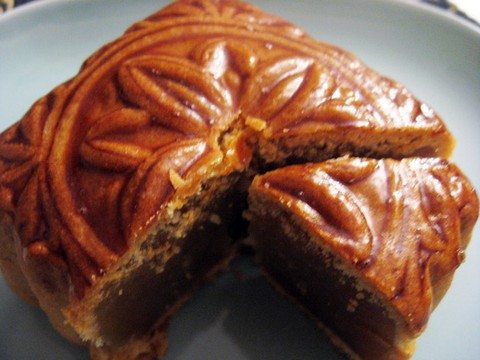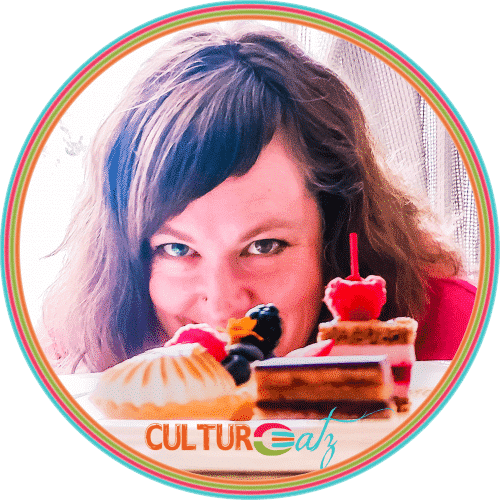Please cast you vote for me to be the next food blog star! Just click here for my official entry Thank you! Voting end Sept 23rd 6opm PST, hurry!
Today, September 22nd, Chinese people around the globe will be celebrating the fifteenth day of the eighth month of the lunar calendar. Coinciding close enough with fall, this is a celebration of the supposed fullest and roundest full moon of the year. It is called Mid-Autumn Festival or Moon Festival.
Chinese families and friends gather to moon gaze, feast and dance. For 2,000 years this festival has had the purpose of communing with the heavens (deities) and giving thanks for the harvest of year.
Traditional foods include lobster, salmon, pomelo citrus, apples, pomegranates, Black Horn Nut, roasted peanuts and of course the mooncake. I was in Chinatown about 2 weeks ago on a Saturday and the stores were filled with these mooncakes. You could by them individually or in boxes of four. Of course I bought one to try as you can see below.
I never heard of mooncakes before till a month ago. A foodie in the Montreal food blogger circuit said they wanted to try making some but it was complicated. From there I did a tiny bit of reading up on it but I had not realized the significance until I went shopping in Chinatown.
The traditional mooncake is round or rectangular, measuring about 10 cm across and 5 cm thick. A decorative thin 2-3mm crust protects a luscious dense filling usually made from lotus seed paste . So mooncakes have inside the filling one or more yolks from salted duck eggs representing the full moon. The top pf the cake has a Chinese symbol usually wishing health or harmony or longevity. Nowadays most people buy them as they are labor intensive…as in some recipes take days till you get the final product.
The crust is usually made from a lard based dough. But today there are vegetarian versions and also really experimental ‘crusts’ with gelatin or glutinous rice preparations in all colors of the rainbow. The traditional filling is a lotus seed paste but it can also be made from bean paste or jujube paste. But now you can even get ice cream filling, green tea, chocolate, pineapple…..and many more!
There are plenty of recipes online if you wish to try your hand at making these mooncakes. You’ll need to buy a mooncake mold. The traditional mold is made of wood but you can find some in plastic and aluminum for a small price. And for some of us finding the prepared can of lotus seed paste may be a challenge…but you can improvise.
Mooncakes are rich so a small piece is plenty. The traditional way to serve this cake is cut into small triangle wedges. You can accompany it with a nice pot of Chinese tea.







Evelyne, we shared a commonality of knowledge this past month. I also had never heard of mooncakes until some Asian Foodie bloggers attempeted to make their own beautiful masterpieces. I personally can appreciate their beauty, however, I get the feeling that I wouldn’t particularly like the heaviness of the dessert itself.
Thanks for all the explanation behind this meaningful event.
Happy Moon festival ;o)
Claudia
Ooh these look yummy! It’s so much fun to try something new and learn about a tradition from a different culture!
Mooncakes mooncakes, everywhere right now! I’ve never tried one as I’m too stingy but I’ve been looking at so many lately I’m feeling the need to fill the mooncake shaped void in my tummy.
RUN Conor to get some now! Or wait till tomorrow and maybe they will be half price lol, like chocolate at Easter!
Happy Mooncake Festival Nathalie! That is too funny…did you know I meant you when I said a foodie I know wants to make some lol.
Happy Mooncake Festival Evelyne! Got so busy, did not have time to go hunt for the molds to make them. Maybe next year! I will try to get some this week-end, as they will still be available in Chinatown. A friend of mine even bought some at Costco. The Macau version. Should have bought some this summer when I was in Macau and Hong Kong, but my suitcase was already full of tea and teapots 🙂